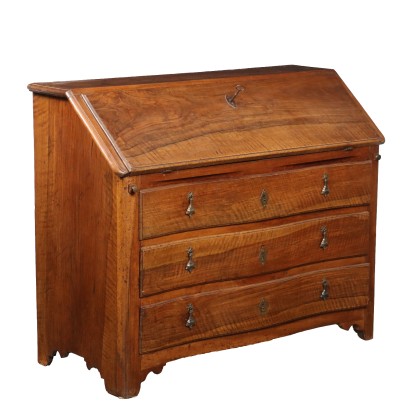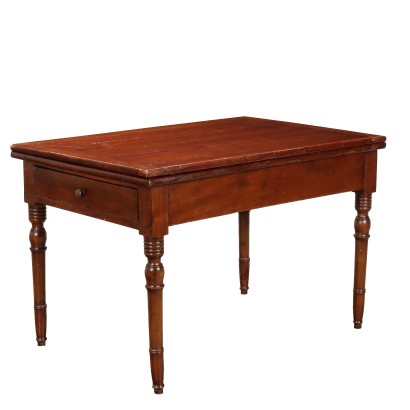Antique Directoire Flap Cabinet Olive Wood Italy XIX Century - Italy, Early XIX Century
Features
Italy, Early XIX Century
Style: Directoire (1790-1804)
Age: 19th Century / 1801 - 1900
Origin: Italy
Description
Directoire flap supported by truncated pyramidal legs, has two drawers plus two side by side placed in the upper band; pair of removable pullers allows the support of the folding door and concealing cabinet with drawers and central compartment. In olive wood, the interiors are in fir; handles and vents replaced.
Product Condition:
Product which due to age and wear requires restoration and re-polishing. We try to present the real state of the furniture as completely as possible with photos. If some details are not clear from the photos, what is stated in the description applies.
Dimensions (cm):
Height: 105
Width: 114
Depth: 53
Additional Information
Style: Directoire (1790-1804)
In this short period of time we witness, in the furniture, an accentuation of the archaeological rigor and at the same time an accentuated linear severity is formulated that in fact preludes and anticipates forms and ornaments that will then be typical of the Empire style.The Direttorio period furniture abandons the delicate pastel colors that characterize the Louis XVI production in favor of the dark magnificence of mahogany, which in its vast range of essences will be by far the most appreciated wood in this period.
Added to this is a general abandonment of floral inlay trends to which simple ebony or amaranth stained wood threads are preferred, the most fashionable is the inclusion of slight linear brass profiles.
The novelties are grafted on a trend that usually finds types already widespread in the neoclassical era, and in some cases there is no lack of significant innovations: the chairs, often painted in light colors and archaeological motifs, are distinguished by the typical backrest upholstered or finished with openwork which is rolled "en crosse" and "S".
The rear legs are all the rage when curved like a saber and the wraparound backrest type, known as a gondola, is widespread.
For studies and libraries, models of chairs characterized by a high concave backrest, called "en hémicycle", with a usually solid structure and with a seat covered in leather, spread.
The use of the secrétaires is widespread and the type of toilet is completely new, now similar to a console on which rests a tilting mirror within hinged plates.
Certainly the most imaginative novelty of this period is the graceful psyche, consisting of a large oval-shaped or rectangular mirror, mounted within high wooden supports and generally supported by saber-shaped legs.
This is the era where the oval or round dining table is very popular, while the desk continues to maintain the shape of the à bureau plats models already known in the previous era.
In this period there are no particular technical-constructive innovations, the technologies remain those already in use since the beginning of the mid-eighteenth century.
Find out more about the Directory with our insights:
The game table, this unknown
Age: 19th Century / 1801 - 1900
19th Century / 1801 - 1900Other customers have searched:
Ribalte, trumeau, bureau, ribalta con alzata, cassettiera con ribalta, scrittoio, secretaire, stipo..
Dai un'occhiata anche ai nostri approfondimenti sul blog e alle presentazioni dei prodotti FineArt:
Leggi di più
Un cassettone a ribalta, espressione del gusto veronese di pieno Settecento
Secrétaire, il mobile con i nascondigli
Scrittoio a dorso d'asino, Piacenza, metà XVIII secolo
Cassettone a ribalta, Roma, secondo quarto XVIII secolo
Ribalta a urna, Milano metà XVIII secolo
Secrétaire, Bottega Francesco Maggiolini, primo quarto XIX secolo
Secrétaire, “Bottega dei fondi verdi”, inizi XIX secolo
Trumeau con anta a ribalta, Queen Anne, Inghilterra 1705 ca.
Sull'antiquariato in generale dai un'occhiata anche a:
Classic Monday: da un pezzo dei nostri magazzini alla storia dell'antiquariato
L'antiquariato dalla A alla Z: il Dizionario dell'Antiquariato
Il dizionario dell'antiquariato - Lastronatura
Il dizionario dell'antiquariato - Mascherone
Il dizionario dell'antiquariato - Natura morta
Il dizionario dell'antiquariato - Opificio
Il dizionario dell'antiquariato - Pastiglia
Il dizionario dell'antiquariato - Savonarola
Il dizionario dell'antiquariato - Rosone
Intaglio barocco con motivo a ricciolo
Leggi di più
Un cassettone a ribalta, espressione del gusto veronese di pieno SettecentoSecrétaire, il mobile con i nascondigli
Scrittoio a dorso d'asino, Piacenza, metà XVIII secolo
Cassettone a ribalta, Roma, secondo quarto XVIII secolo
Ribalta a urna, Milano metà XVIII secolo
Secrétaire, Bottega Francesco Maggiolini, primo quarto XIX secolo
Secrétaire, “Bottega dei fondi verdi”, inizi XIX secolo
Trumeau con anta a ribalta, Queen Anne, Inghilterra 1705 ca.
Sull'antiquariato in generale dai un'occhiata anche a:
Classic Monday: da un pezzo dei nostri magazzini alla storia dell'antiquariato
L'antiquariato dalla A alla Z: il Dizionario dell'Antiquariato
Il dizionario dell'antiquariato - Lastronatura
Il dizionario dell'antiquariato - Mascherone
Il dizionario dell'antiquariato - Natura morta
Il dizionario dell'antiquariato - Opificio
Il dizionario dell'antiquariato - Pastiglia
Il dizionario dell'antiquariato - Savonarola
Il dizionario dell'antiquariato - Rosone
Intaglio barocco con motivo a ricciolo
Product availability
The product can be seen at Cambiago
Immediate availability
Ready for delivery within 2 working days from ordering the product.





















































